
Notes From Olympia: Feb. 17, Week 6 of the 2023 Legislative Session
This edition includes trivia, policy and fiscal cutoff deadlines, details on Transitional Kindergarten and maternal health bills, a preview of the latest caseload forecast and information on differentiating between striker and substitute bills.
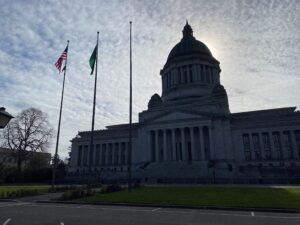 The Legislative Building from the north side on Super Bowl Sunday.
The Legislative Building from the north side on Super Bowl Sunday.
Note the third flagpole is not flying the Seahawks flag. There’s always next year …
(Photo Credit: Erica Hallock)
Trivia!
How old were the “Keepers of the Capsule” who, during Washington state’s Centennial celebration in 1989, pledged to preserve the time capsule designed to commemorate the Centennial and to enlist future generations to update the capsule contents and continue the tradition?
Cutoff Time
Policy Cutoff. The first cutoff is today (Friday, Feb. 17), with a deadline for bills to pass out of policy committees. After this cutoff, we will have a better idea of what is still in play. It is not uncommon for bills to be amended (sometimes substantially) to keep the issue alive. We are at the stage in the legislative process where bills can change on a dime, so it’s wise to keep the legislative website handy and check it frequently for bills you care about.
Fiscal Cutoff. Next week will be filled with marathon (likely late night) meetings in the fiscal committees as the Feb. 24 fiscal cutoff looms. As of this writing, the Senate Ways and Means Committee has a Saturday Feb. 18 meeting scheduled.
Testimony in fiscal committees differs from policy committees in that fiscal chairs request testifiers to speak to the fiscal aspects of the bill, rather than make a policy case. Short and sweet and a minimal number of testifiers is advised!
Bill Hearings
The Transitional Kindergarten bill passed Education Committee with amendments. The House Education Committee passed a Substitute House Bill 1550 Tuesday, which can be seen on TVW starting at the 42:30 minute mark. This bill would codify (make official in law) the Transitional Kindergarten program and convert it to a new Transition to Kindergarten (TTK) program with distinct roles for both the Office of the Superintendent of Public Instruction (OSPI) and the Department of Children, Youth and Families (DCYF).
Changes made to the bill as compared to the original version include:
- Clarification that school districts can play a vital role in providing services to young children, particularly in early learning deserts
- Legislative intent to convert existing Transitional Kindergarten programs to TTK if the program standards outlined in the bill are met
- A requirement that school districts applying to operate or expand a TTK program must consider the availability of existing early learning providers and enact a memoranda of understanding between the district and other early learning providers and the development of a model memorandum of understanding by OSPI and DCYF
- TTK sites must implement the following elements in alignment with Early Childhood Education and Assistance Program (ECEAP) performance standards: classroom environment, pedagogical approach and safety measures
- Direction that OSPI and DCYF consider existing availability of ECEAPs, Head Start and licensed child care when coordinating authorization of school districts to offer a TTK program, approval of TTK program sites, and capping of eligible child enrollment
- The elimination of the requirement for full school day and full school year programs and instead directs OSPI to prorate funding for partial day and partial year
Education Committee members stressed that their goal is to ensure school districts and other early learning providers work together to expand access to high quality opportunities for young children. The bill now moves to the House Appropriations Committee and awaits a hearing.
The Senate Committee amended and approved the “Improving Maternal Health Outcomes” bill. The Senate Health and Long Term Care Committee passed Senate Bill 5580, which can be seen on TVW beginning at the 1:40:30 minute mark. This bill would create a post-delivery and transitional care program and allow five additional days of hospitalization after birth for women with a substance use disorder. The bill would also update the current Maternity Support Services (MSS) program to address perinatal outcomes and increase equity and healthier birth outcomes. The committee amended the bill to extend the deadline for implementing the post delivery and transition care program and changes to the Material Support Services (MSS) program from Jan. 1, 2024, to no later than Jan. 1, 2025. The bill now awaits a hearing in the Senate Ways & Means Committee.
Caseload Forecasts Released
On Feb. 10, the Washington State Caseload Forecast Council met to receive updated caseload forecasts. These caseload forecasts inform the writing of the budgets by providing insight into expected costs for forecasted programs like K-12 education, nursing home usage and foster care.
Following are caseload forecasts for early learning related programs. Two items of note: 1) the changes reflect projected increases or decreases from the November 2022 forecasts and 2) Transitional Kindergarten is not separately forecasted.
Early Support for Infants and Toddlers (ESIT)
- State Fiscal Year 2023 projected caseload: 11,012 (+16/+.1%)
- State Fiscal Year 2024 projected caseload: 11,649 (+78/+.7%)
- State Fiscal Year 2025 projected caseload: 12,226 (+167/+1.4%)
Early Childhood Education Assistance Program (ECEAP)
- State Fiscal Year 2023 projected caseload: 11,962 (-697/-5.5%)
- State Fiscal Year 2024 projected caseload: 14,168 (-269/-1.9%)
- State Fiscal Year 2025 projected caseload: 14,490 (-415/-2.8%)
Working Connections Child Care (WCCC)
- State Fiscal Year 2023 projected caseload: 24,079 (-221/-.9%)
- State Fiscal Year 2024 projected caseload: 26,520 (-872/-3.2%)
- State Fiscal Year 2025 projected caseload: 28,368 (+233/+.8%)
In the forecast narrative, risks to the ECEAP forecast include a tight labor market and potential competition from other early learning programs. For Working Connections Child Care, the narrative notes that while provider availability has not restricted caseload growth so far, there could be a risk to the caseload associated with supply limits.
Striker and Substitute Bills
What’s the difference between a striker and a substitute bill? The process for a bill to become a law is a lot more complicated than Schoolhouse Rock led us to believe. Like other governmental bodies, the Washington State Legislature deploys many different processes and avenues to add or make changes to law.
At this point in the legislative session, you may hear references to “substitute bills” or “striking amendments” on legislation you are following. A “substitute bill” is a new version of an existing bill substituting the original bill with new content. Substitute bills can only be offered by a committee in the bill’s house of origin during a committee hearing or executive session (voting session). A “striker amendment” or “striker bill” removes – or strikes – everything after the title of the bill and inserts new language, usually major changes to the underlying bill.
The main difference between the two is where the change to the bill happens: “substitutes” can only happen in committee in the house of origin and “strikers” happen on the floor or in the opposite chamber. If you’re interested in learning more about the legislative process, the legislature has a host of information including a detailed guide to reading bills. The University of Washington Office of Budget and Planning also provides a great overview.
Bill Tracker: Key Early Learning Bills
As the legislative session progresses, our resource page will update with a weekly bill tracker. Please note that legislation changes quickly, so the version on our website may not represent a bill’s latest version as it is published the Thursday of each week.
Trivia Answer
“Keepers of the Capsule” were 10-year-old Washington state children with birthdays on or near the state’s Centennial of Nov. 11, 1989. These original Capsule Keepers were volunteers who pledged to preserve the Washington State Centennial Time Capsule and enlist a new generation every 25 years. The project continues to be supported by the Office of the Secretary of State.
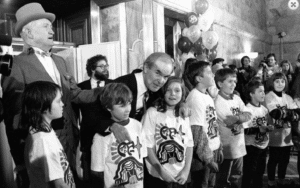 Former Washington State Secretary of State Ralph Munro (in top hat) and former Governor Booth Gardner with original “Capsule Keepers” at the Nov. 11, 1989 celebration at the Capitol.
Former Washington State Secretary of State Ralph Munro (in top hat) and former Governor Booth Gardner with original “Capsule Keepers” at the Nov. 11, 1989 celebration at the Capitol.
(If you remember the trivia a couple of weeks ago about the Centennial celebration, I am guessing Secretary of State Munro still had on his “period fashion show” clothing.)
(Photo Credit: Keepers of the Capsule)
I recently interviewed one of these original “Keepers of the Capsule,” Jennifer Estroff. In 1989, Jennifer was a fourth-grade student at Harbor Heights Elementary in Gig Harbor (Go Orcas!) when she brought home a letter advertising this project. Her parents agreed this could be fun and they mailed in the form. Little did they know that some 34 years later, Jennifer would remain extremely active and committed to this effort.
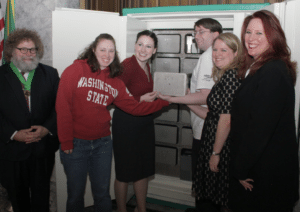 Original “Keeper of the Capsule” Jennifer Estroff (in red holding a capsule) alongside former Secretary of State Kim Wyman (far right), Time Capsule Organizer Knute Berger (far left) and other 1989 Capsule Keepers on February 2015
Original “Keeper of the Capsule” Jennifer Estroff (in red holding a capsule) alongside former Secretary of State Kim Wyman (far right), Time Capsule Organizer Knute Berger (far left) and other 1989 Capsule Keepers on February 2015
(Photo Credit: Washington State Secretary of State)
Jennifer provided a wealth of information about the origin and evolution of the project. She shared that in 1988, former Secretary of State Ralph Munro and Washington Centennial Commission Executive Secretary Putnam Barber wanted to identify a project to engage youth.
The Centennial Commission hired journalist Knute Berger to develop a time capsule concept that would engage the public. Berger had researched why time capsules often failed (largely because they get buried, forgotten and lost) and came up with the idea of a visible, updateable time capsule. (Berger wrote a great Crosscut piece back in 2014 anticipating the first 25-year update.)
Back to 1989, the roughly 300 “Capsule Keepers” were given t-shirts and were sworn in, making a commitment to oversee the capsule as well as to recruit new keepers. Science fiction author Greg Bear wrote the Keepers of the Capsule oath:
“We hereby swear to ensure the continuity of these capsules, to watch and ward over the past, present, and future heritage of the State of Washington contained herein, and to pass our responsibility on to the next generation of Keepers of the Capsule.”
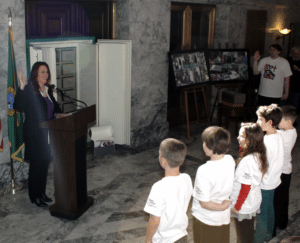 Former Secretary of State Kim Wyman swears in a new batch of “Capsule Keepers” in 2015
Former Secretary of State Kim Wyman swears in a new batch of “Capsule Keepers” in 2015
(Photo Credit: Washington State Keepers of the Capsule)
The capsule itself was constructed by the Westinghouse Hanford Company. It weighs 3,000 pounds and holds a series of 16 stainless steel individual time capsules. The idea is that each of the 16 individual time capsules would be filled with new items every 25 years. All of the capsules are expected to be opened in 2389, the state’s 500th birthday. The capsule is located at the southern end of the Legislative Building. Some of the items added to the inaugural 1989 capsule include a Nordstrom catalog, a silver Boeing 747 pin and a license plate dated “2389” – the year of the state’s 500th birthday.
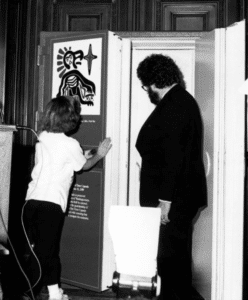 Knute Berger oversees the closing of the capsule in 1989
Knute Berger oversees the closing of the capsule in 1989
(Photo Credit: capsulekeepers.org )
The Capsule is checked every two years to make sure moisture or other elements do not damage the capsule contents. A second individual capsule was filled in 2014 at the first 25-year marker. Jennifer reported that she added her lapel pin commemorating the passage of Referendum 74, creating marriage equality and Amazon added a Kindle containing books by every Washington author. Jennifer made a good point that any item included in the time capsule operated by technology must be accompanied by directions so that future openers of the capsules can fully experience their inclusion. (Think VHS tapes).
The original 1989 group is now in their 40s and they are looking to diversify and pass this legacy to the next generation.
Jennifer noted that if you are on a tour of the Capitol, make sure the tour guide stops and explains the time capsule. Too many people (including me!) walk right past it and do not pause to think about its story.
Thank you to Jennifer for sharing your memories and experience!
Sources: Washington State Keepers of the Capsule website and Keepers of the Capsule Facebook page
About the Author
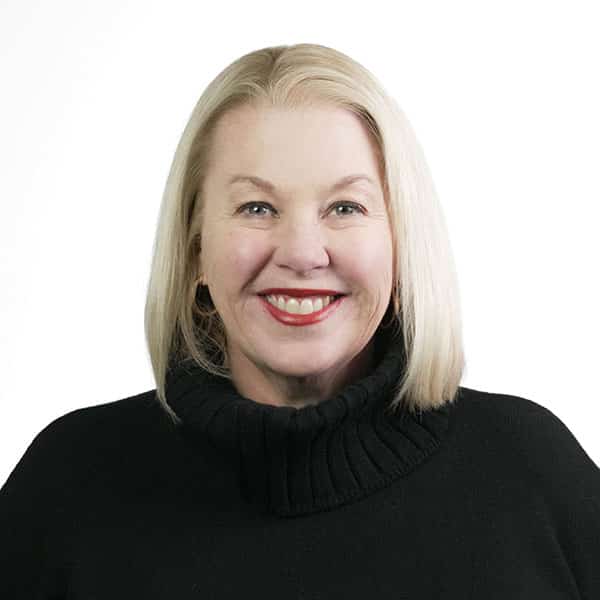
Erica Hallock
Director, Policy & Advocacy, Start Early Washington
Erica Hallock serves as the Director of Policy and Advocacy for Start Early Washington. She has worked in early childhood, health and human services policy in both California and Washington state.
More Like This
Contact Us
Connect with our team to learn more about our work or discuss how we can support policy and advocacy work for your organization.
Washington State Hub
Learn more about our work in Washington state and access relevant resources and publications.
